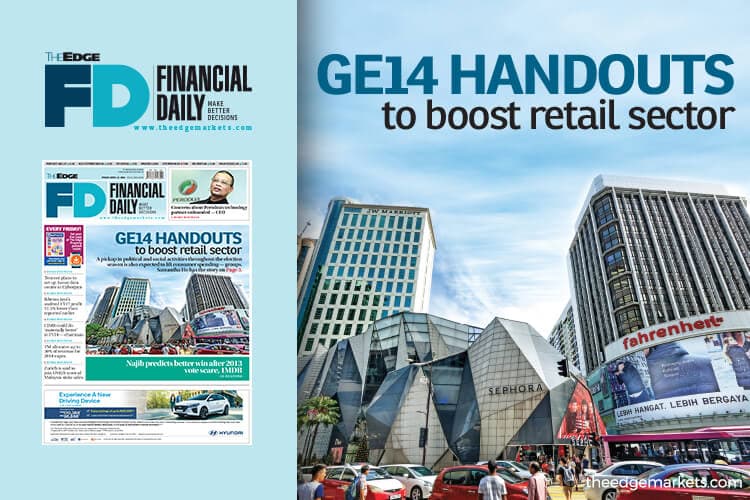
This article first appeared in The Edge Financial Daily on April 27, 2018
KUALA LUMPUR: The rain of monetary goodies announced by the caretaker government in the run-up to the 14th general election (GE14) — expected to be the most heated the country has seen — and a pickup in activities this polling season could give the sluggish retail sector a much needed boost.
In fact, the industry is expecting a near-term boost ahead of GE14.
“Over the past two weeks and up until May 9, people will be spending more,” said Tan Hai Hsin, managing director of Retail Group Malaysia.
Caretaker Prime Minister Datuk Seri Najib Razak on April 15 announced a free RM800 fuel card for some 67,000 taxi drivers.
Tan Sri William Cheng, president of the Malaysia Retailers Association (MRA) and chairman of Parkson Holdings Bhd, said that the increase in political and social activities throughout the election season will also lift consumer spending.
“GE14 may be one of the reasons Malaysian consumers adopted a wait-and-see approach,” Cheng said at a one-day retail conference organised by the MRA yesterday.
“Post-election, consumer spending is expected to improve further as Malaysians focus on their own economic future and release pent-up demand,” he said. Tan concurred, saying that election-driven sentiment and the recovery of the ringgit are likely to be the major factors impacting retail growth this year.
In early April, just days before Parliament was dissolved, Najib also announced that the government would allocate RM1.46 billion as salary increments for the civil service, effective from July 1.
Tan also noted that a weak 2% retail growth in 2017 indicated that consumer spending still had not recovered from the implementation of the goods and services tax (GST) after two years.
“But we cannot just blame GST because the ringgit also depreciated within the same time period,” he said.
Despite the recent exit of several large foreign brands such as Tim Ho Wan, Bulgogi Brothers and True Fitness, Tan said foreign interest in Malaysia’s retail scene remains strong, especially in Johor Baru.
In the first quarter, 24 brands from 15 different countries opened their first outlet in Malaysia, he noted. These were mostly food and beverage outlets, with the majority coming from Singapore and Taiwan into the Klang Valley, Johor, Pahang and Seremban.
“It shows a lot of people are still interested in coming to Malaysia despite the weak retail growth numbers,” Tan said. Retail Group Malaysia estimates a 4.7% year-on-year growth rate, with a turnover of RM104.4 billion, for 2018. An estimated 5.4% growth in the first quarter of the year is expected to slow to 3.7% in the second quarter, Tan said.
However, the sector is likely to continue facing disruptions and challenges in coming years, partly due to the disruption of the e-commerce industry, according to Cheng.
“It depends on how the malls and the retail businesses will react to millennial customers and challenges from e-commerce,” he said.
“What retailers need now is improvement in consumer spending. When economic growth is broad-based, more Malaysians will have higher take-home pay and [therefore] higher purchasing power,” Cheng added.
Tan pointed out that since 2012, retail growth has remained well below both gross domestic product growth as well as private consumption figures, which include spending on housing, services, and dining out, among other things.
Bricks and mortar still relevant
Despite the common perception that a growing e-commerce market is crowding out physical retail outlets, Tan said that this is not happening in Malaysia anytime soon. He noted that in mature markets such as the US, online retailers have a similar survival rate as bricks-and-mortar stores.
“We will go through that correction one day,” Tan said, noting that the lower regulations and costs associated with starting an online business mean that less mature markets are flooded with such companies in the early stages.
Online retail sales of goods account for about 2% of total retail sales following an “online explosion” in recent years, he pointed out.
Tan said that traditional bricks-and-mortar retailers could also get into the digital space by selling their products online.
The converse is also true, as online marketplaces such as Lazada and Zalora carry 60 brands and 71 brands, respectively, that have stand-alone physical stores in Malaysia, he pointed out.
“Successful Malaysian retailers in the future are the ones who are able to sell their products through multiple channels, including through physical stores, desktops, tablets, and mobile phones,” MRA’s Cheng said.
Allan Soo, deputy executive chairman of Savills Malaysia, said that Malaysia is currently seeing a convergence of both online and offline retailers as well as payment systems.
“A more sustainable format of growth may also involve downsizing and rightsizing,” said Soo, who pointed out that as large supermarkets and hypermarkets are seeing declines, smaller and more specialised retailers are still seeing room for growth.